

Wood flooring is tried and trusted option for homeowners looking for a beautiful and durable option for their interior’s floors. But how do you choose the right style and type for your home?
Your self build or renovation budget will dictate which type of wood flooring product you choose, but it’s also important to factor in your project goals and overall style. For example, are you looking to create an eco home or sustainable self build? Timber flooring is a sustainable and recyclable product, so it merits serious consideration. And, if you make sure you invest in Forest Stewardship Council (FSC) certified stock, you know your boards have come from a reputable source.
Whichever type of wood flooring you select, timber is unique in every application; the aesthetic variations thanks to the grain, knots, markings and colour are vast. The most popular product choices are solid or engineered wood flooring boards, both of which have a broad range of benefits and are constantly evolving. This contributes to making flooring easier to install and more affordable than ever before.
Prior to picking a wood flooring product, have a serious think about your flooring needs. It’s wise to consider the basics, such as where in the property you’re going to lay it. Want it in the kitchen? Then you’ll need something that’s water and stain resistant. Considering a hallway application? You’ll require a hardy covering. In relation to longevity, are you hoping your wood flooring will last for decades? If so, make sure you allocate enough of your self build or renovation budget to secure a high-quality product and pay attention to how you can properly maintain it.
Let’s take a look at the most popular types of wood flooring, their pros, cons and what you need to consider when planning out a successful scheme.
This type of wood flooring is coveted by self builders and renovators alike, mostly because it has an inherent beauty and depth that’s hard to match. It will add a touch of luxury to your interiors and provide you with a gorgeous feature.
When sourcing solid wood, you need to look at the grade to check its quality – you really do get what you pay for. At the top end, you’ll find premium products that come from heartwood. This should be fairly uniform in colour, have a smooth finish and be virtually free of knots. For high-quality solid wood boards, you can expect to pay around £55 per square metre up to £95 and beyond.
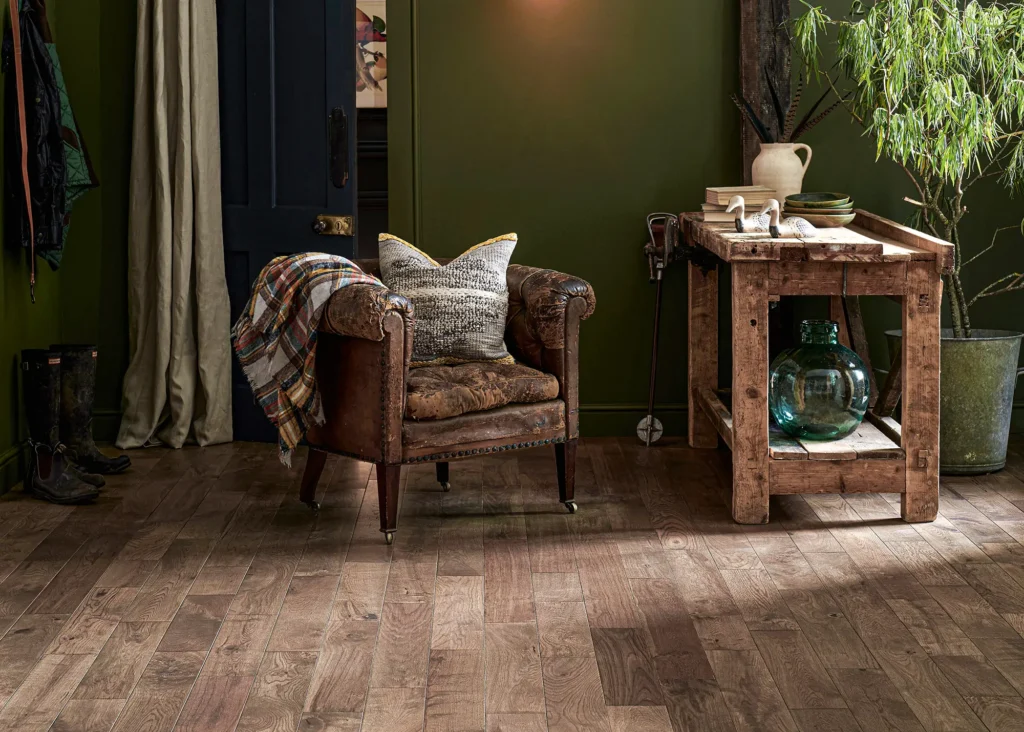
Woodpecker Flooring’s York Tawny Oak is a solid wood floor in a dark and rich tone, priced at £96 per m²
Timber described as rustic will have more knots and a greater degree of tonal variation – which some people adore as it can have a bit more character about it. Think about what type of wood you would like and the hue that the timber will offer. Oak and walnut are sought-after choices; they are both highly durable and have a good depth of grain and colour. If you are looking for something different, consider a tropical timber – African Iroko is easy to source and has a stunning hue, plus it’s extremely hardwearing.
Softwood makes good flooring, too. Pine is a popular and affordable option. It is not quite as durable as the hardwood alternatives, but this doesn’t have to be an issue as long as you avoid using it in high-traffic zones. Larch and Douglas fir are harder wearing softwoods.
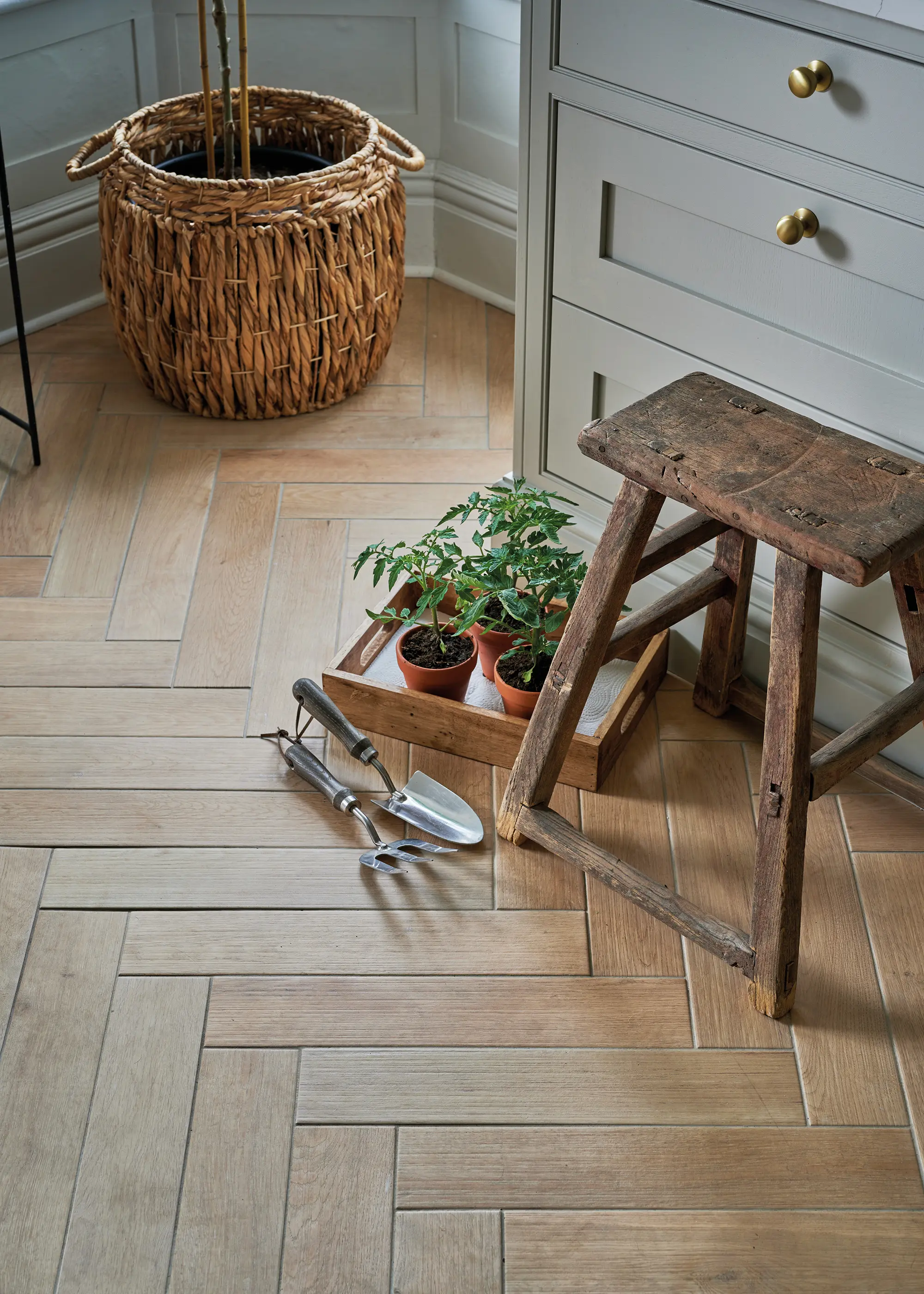
These porcelain wood-effect tiles cleverly emulate an oak floor, looking stylish wherever positioned in your home. Chatham porcelain oak, £79 per m², Ca’ Pietra
In terms of maintenance, surfaces should be cleaned with specialist products that enhance the wood. Consider buffing the boards with wax every six months or so, and invest in chemical-free cleaning products that won’t impact on the colour.
Solid timber can be sanded and refinished multiple times without it affecting the material’s strength – hence it can still look great after many decades. You can avoid dents and scratches, too, by putting pads under furniture.
FAQ Can you install wood flooring over underfloor heating?Timber expands when warmed and contracts when cold, so wood flooring can be susceptible to movement if it’s installed over underfloor heating (UFH). “Engineered wood flooring is the best choice for use with underfloor heating due its high level of stability and resistance against warping,” says Thea from Russwood. “They are also a little thinner than solid, allowing heat to transfer more efficiently. solid wood can also be used, but requires greater care with site preparation,” says Thea. Solid wood flooring needs a moisture content of below 8% to prevent warping. “There are many engineered boards now which look exactly like solid wood and these are a much safer option,” says Greg from Havwoods. In summary, you can install wood flooring over underfloor heating, but be careful about which product you choose and always speak to your supplier to find out what they’d recommend. These Oxwich Coffee Strand bamboo boards from Woodpecker Flooring are coated in a deep-toned lacquer for a sleek and satin-smooth finish. This flooring makes a durable option that will work well even in humid spaces Options such as bamboo wood flooring can also make a high-performance option, offering great resistance against moisture and humidity – perfect for those rooms with underfloor heating. It’s available in both solid and engineered constructions. As bamboo is a fast growing grass, it can be sustainably harvested making it a natural choice for homes concerned with the environment. |
Robust, durable and easy to fit, engineered wood flooring is made up of several layers (at least three) of timber that’s pressure-joined for strength. You need to pay special attention to the top one (the wear layer). As a guide, the thicker the wood flooring boards are, the better the quality. Beneath this are the base sheets, typically made of plywood (or other inexpensive wood products). This layering gives engineered boards their rigidity, strength and stability – something that solid wood flooring can’t quite match.
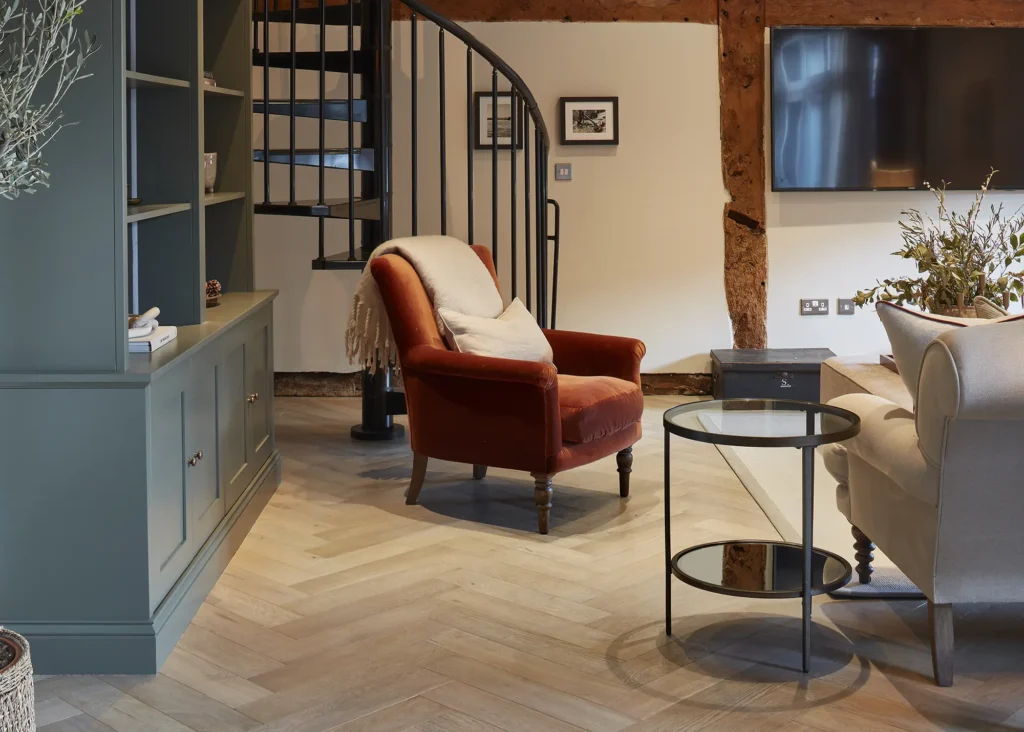
Pictured is the Mierlo Rustic Herringbone timber flooring from Havwoods. The wood flooring costs £69.96 per m². Photo: Malcom Menzies
In terms of costs, this again will have much to do with the wear layer; hardwood veneers are more durable than softwoods. It will be made up of one, two or three strips – a single, thick layer being the premium option. Three is the most affordable, mainly as the narrower pieces mean there is less wastage in production. Engineered wood floors are generally cheaper than solid, starting at around £30 per m².
Engineered wood flooring expands and contracts less when there are changes in humidity and temperature, so it can be used in a kitchen or bathroom. It’s also a viable option for underfloor heating, as it is stable enough to resist warping; although it’s not as conductive as tiles or stone.
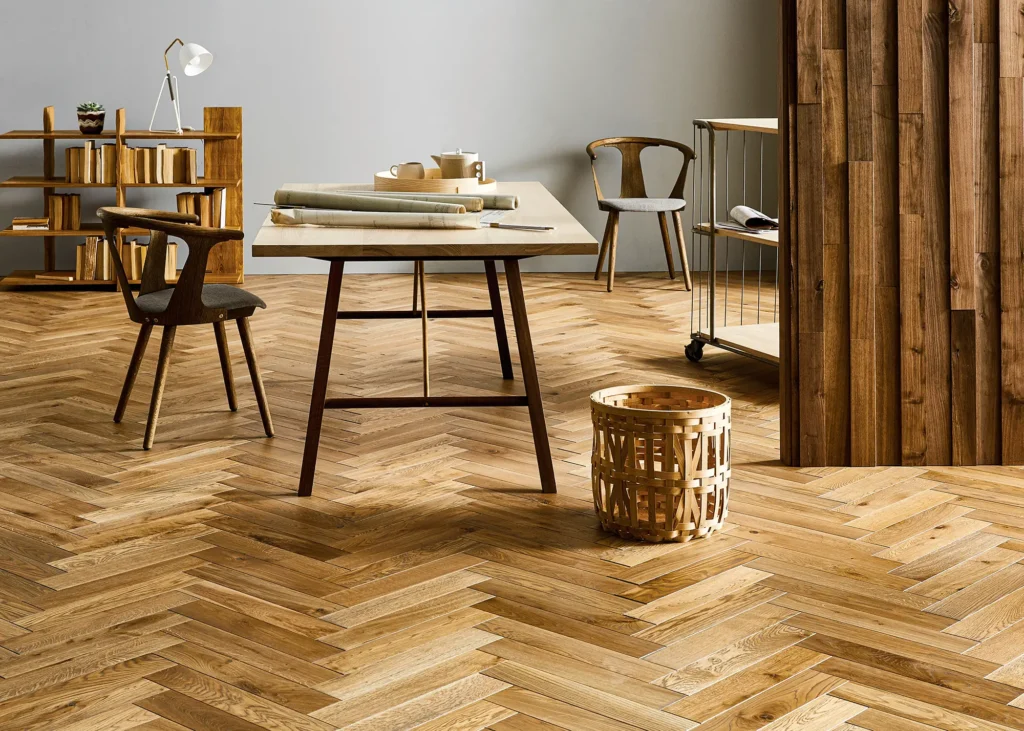
The Pankhurst herringbone wood flooring design from Ted Todd is packed with character and texture
In terms of maintenance, there is a limit to how often you sand and refinish engineered wood flooring – it all comes down to the thickness of the wear layer. As a guide, 4mm thick veneers can be sanded up to three times in the life of the product, and up to five times for something that’s 6mm deep. If the wear layer is thinner, always look to consult a specialist before attempting a make-over; you don’t want to damage the integrity of the floor.
EXPERT VIEW Your wood flooring questions answeredGreg Elliot, head of technical at Havwoods, answers some of the key questions to help you specify the right kind of timber flooring for your home What maintenance do timber floors require?An effective maintenance programme will keep the flooring clean and looking as good as possible. However, all floors are unique and will require individual assessment. Changes in traffic levels and seasons will also need to be taken into consideration. As a general rule, wooden floors should be cleaned daily using dry care methods, such as vacuuming. You should also use a damp, sturdy mop regularly to remove soluble dirt. Wooden flooring has a tendency to become scratched and dull over time, so to prevent this, apply a ready-to-use solution to the flooring to improve wear protection. This is ideal for removing heavy stains and marks, too. Is installation straightforward for wood floors?Engineered flooring is often considered DIY-friendly, whereas solid hardwood flooring can be challenging. Engineered versions are often installed using a clicklock or tongue-and-groove system, whilst solid hardwood flooring may be nailed or stapled to a wooden subfloor, which requires a professional with specialist tools. Which kinds of wood flooring work best for a traditional feel, and what’s more contemporary?A brunette or cocoa-coloured wood flooring is usually associated with a period-style interior, so start with a darker colour and pair with a characterful board that has plenty of natural knotting and veining. Typically, early floorboards were generously proportioned, with widths of up to 18 inches, therefore choosing wider planks will naturally create the appearance of a traditional floor covering. For a more contemporary look, choose a lighter wood to contribute to a modern, airy atmosphere and help reflect the light around the room. While patterns such as herringbone and chevron were once traditional, they are now very much back in-style and are often chosen for modern interior design styles. |
Want to create an authentic heritage look? Salvaged or reclaimed wood flooring is a great option. “These are popular due to the combination of their characterful appearance and sustainability credentials,” says Greg from Havwoods. “Bear in mind that when purchasing reclaimed timber, higher costs can be expected and quantities are often limited,” says Thea from Russwood. “Lifting boards is rarely done without damage and finding new boards to match can often be difficult.”
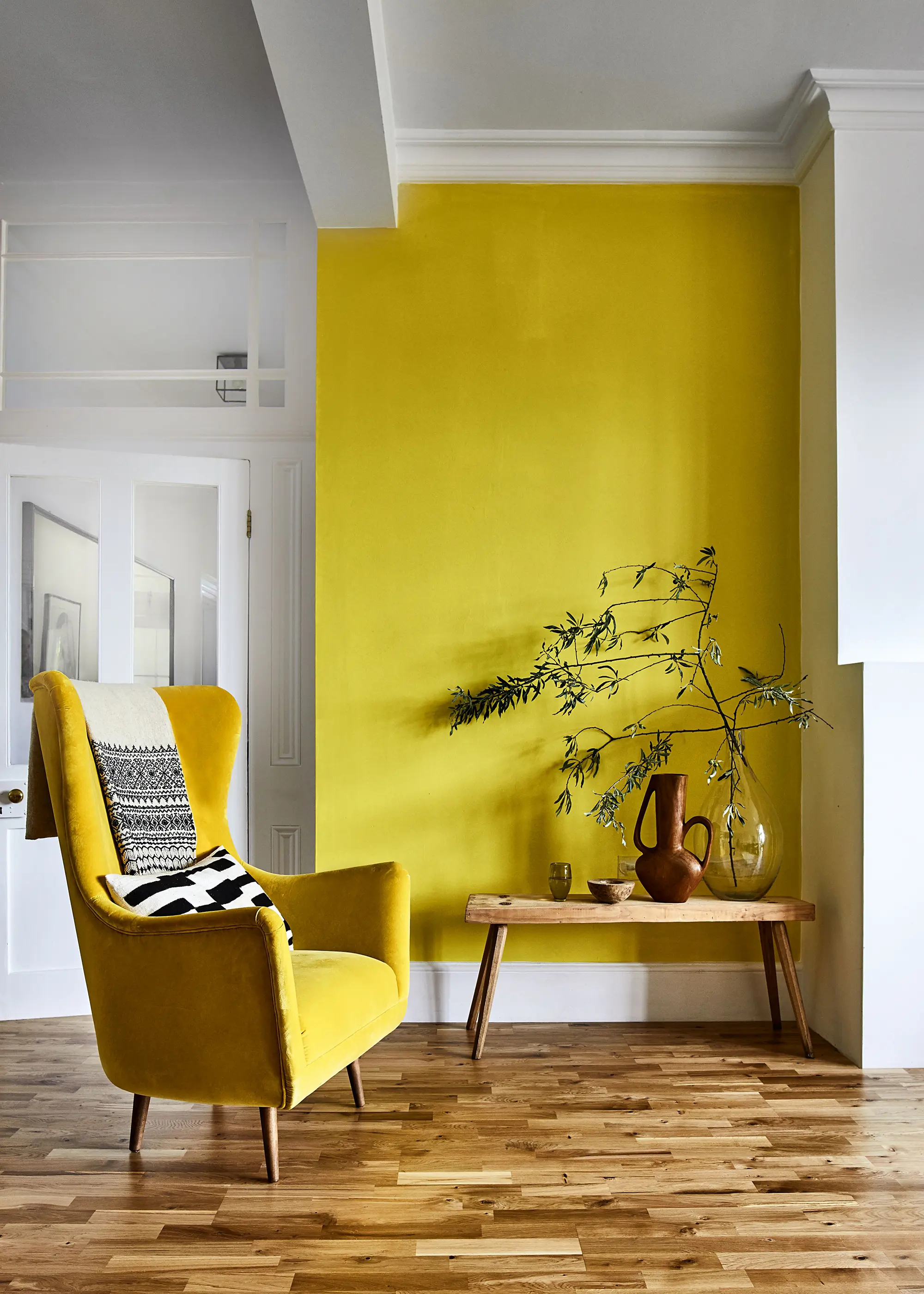
Made from real oak, this engineered wood flooring has a 2.5mm oak veneer thickness with a three strip design. Kahrs Tres Erve matt lacquered wood flooring, £79.99 per m² from Carpetright
“Some new wood flooring products can be manufactured to offer a rustic aesthetic,” says Thea. opting for a brushed-and-oiled finish can achieve a similar look, as this emphasises the wood’s natural qualities. Handscraped finishes even more so, as these have been distressed exclusively for their character. Choose a natural oiled or waxed finish if you want to keep an organic feel, or a UV oiled surface for maximum strength.
Comments are closed.